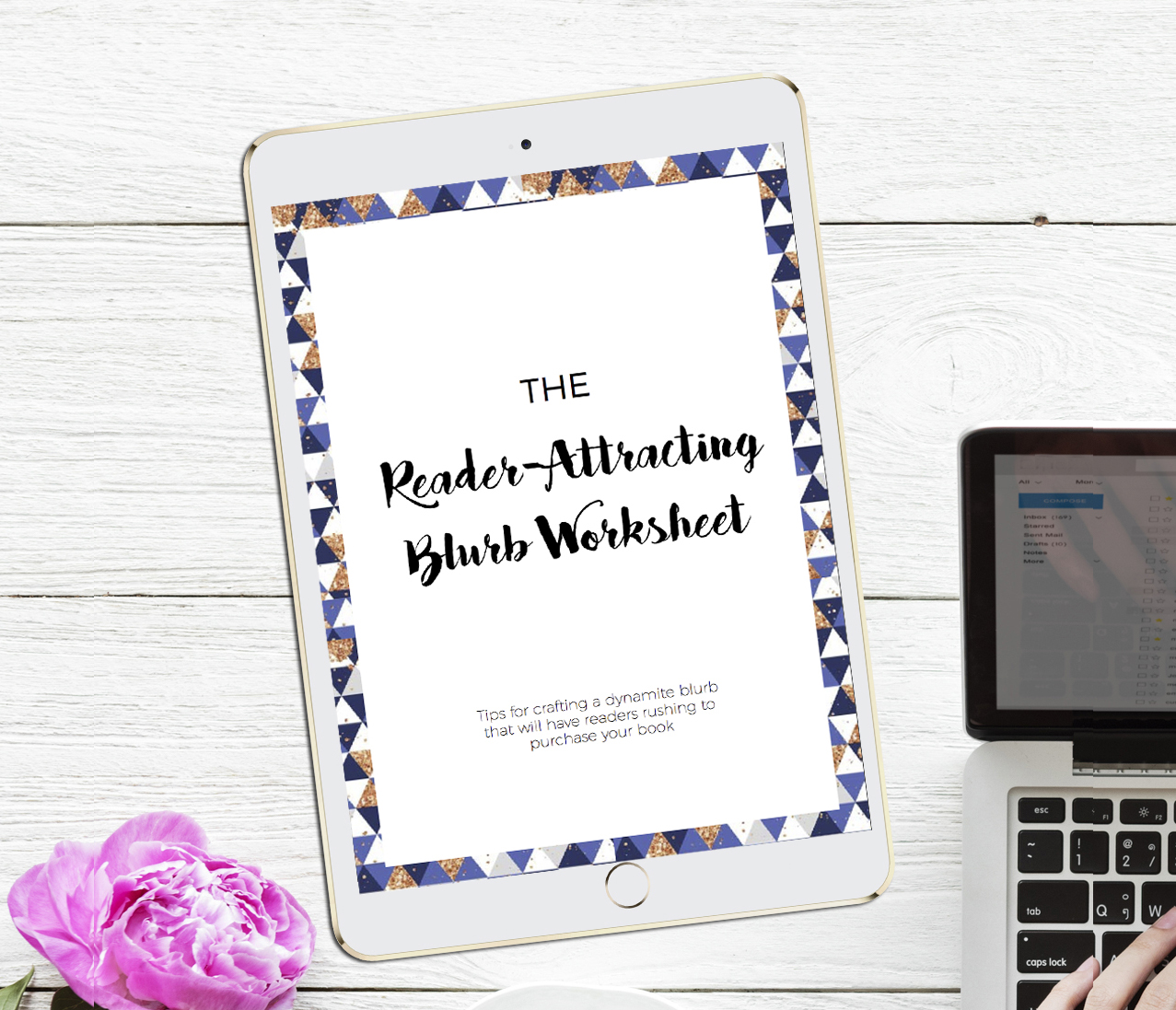On Twitter last week I read an author post saying ‘I’d rather scratch out my eyes than write a blurb for my book’. Surely not. After all, isn’t a blurb just another piece of writing and a very short piece of writing at that.
Okay, okay I get it. You don’t like marketing. You’d rather scratch your fingernail down a blackboard than try to convince someone to buy your book. However, let’s put that to the side for one minute and look at the book blurb for what it truly is – a fantastic piece of copy. This short description is one of your key book selling tools (along with your book cover) the sole purpose of which is to capture your reader’s interest. Your blurb is your chance to draw your readers in with your compelling storyline, evocative characters and cleverly-written plot twists so that they feel that they must (yes, absolutely must) purchase your book. Here then (for the sake of saving you from all scratching out your eyes) are my top tips for writing a reader-attracting blurb in no time.
Hook your reader with the first sentence
Your first sentence should pique the reader’s interest enticing them to read on. Use evocative words, an intriguing setting or place your reader directly in the middle of the action.
Hint at the Story
Set up your story so you create interest but don’t give everything away. Tease your readers by finishing with an unanswered question, a problem or a mystery. Leave them wanting more.
Introduce the Protagonist
Introduce your protagonist in a way that resonates with your readers. You want your readers to identify with your characters. What is that makes your character appealing? How is this relevant to your storyline? Give a sense of how your character fits into your central theme and main conflict.
Keep it succinct
Keep your blurb concise and direct. Aim for between 100 to 150 words. Don’t turn your readers off with a lengthy and boring block of text.
Make it appropriate for your genre
Your blurb sets the tone and atmosphere of your book. It needs to match your reader’s expectations for the genre. Do some research on best-selling books in your genre. Look at what their blurbs have in common. How can you convey the feel and tone of your novel in your blurb?
Replace clichés with emotion
Get rid of any overused phrases and expressions that say nothing about your story. Replace them with emotionally evocative words. Go through your outline and pick out those parts that are attention-grabbing. Your blurb should read like a brief highlight-reel of your book. Cut away any excess.
For non-fiction books
A non-fiction book blurb should state the problem you’re solving for your readers and how you will walk them through the process. It may also help to include an explanation of why you are the best person to solve this problem. How are your background and experience relevant to the topic?
Endorsements
Like a testimonial, a quote from a fellow-author or respected figure can act as a form of social proof. The best endorsements are short, direct and credible. For an endorsement to be valuable it needs to come from a respected figure or organization.
Let’s Check out some examples:
Literary Fiction
Alice Love is twenty-nine, crazy about her husband, and pregnant with her first child.
So imagine Alice’s surprise when she comes to on the floor of a gym and is whisked off to the hospital where she discovers the honeymoon is truly over — she’s getting divorced, she has three kids and she’s actually 39 years old. Alice must reconstruct the events of a lost decade, and find out whether it’s possible to reconstruct her life at the same time. She has to figure out why her sister hardly talks to her, and how is it that she’s become one of those super skinny moms with really expensive clothes.
Ultimately, Alice must discover whether forgetting is a blessing or a curse, and whether it’s possible to start over. - What Alice Forgot by Liane Moriarty.
Blurb perfection. In only 127 words the main character is introduced, the central conflict and setting are established and the reader is left wanting to know more. What has Alice forgotten? How will she solve this mystery? We’ll have to read on to find out.
YA Fiction
Sixteen-year-old Aza never intended to pursue the mystery of fugitive billionaire Russell Pickett, but there’s a hundred-thousand-dollar reward at stake and her Best and Most Fearless Friend, Daisy, is eager to investigate. So together, they navigate the short distance and broad divides that separate them from Russell Pickett’s son, Davis.
Aza is trying. She is trying to be a good daughter, a good friend, a good student, and maybe even a good detective, while also living within the ever-tightening spiral of her own thoughts.
In his long-awaited return, John Green, the acclaimed, award-winning author of Looking for Alaska and The Fault in Our Stars, shares Aza’s story with shattering, unflinching clarity in this brilliant novel of love, resilience, and the power of lifelong friendship.’ – Turtles all the way down by John Green.
This blurb creates empathy by focusing on the central character, a teenager, the embodiment of the author’s target audience. A mystery is introduced along with the central themes of anxiety and friendship. It concludes with John Green’s credentials, an expressive description of his writing style and a reminder of the novel’s themes.
Fantasy
In a world where ash falls from the sky, and mist dominates the night, an evil cloaks the land and stifles all life. The future of the empire rests on the shoulders of a troublemaker and his young apprentice. Together, can they fill the world with color once more?
In Brandon Sanderson's intriguing tale of love, loss, despair and hope, a new kind of magic enters the stage — Allomancy, a magic of the metals. - Mistborn: The Final Empire by Brian Sanderson.
In only 74 words we are placed in the fantasy setting, introduced to the main characters, the central conflict and finally the story’s key themes: love, loss, despair and hope.
Thriller & Suspense
Just after midnight, a snowdrift stops the Orient Express in its tracks. The luxurious train is surprisingly full for the time of the year, but by the morning it is one passenger fewer. An American tycoon lies dead in his compartment, stabbed a dozen times, his door locked from the inside.
Isolated and with a killer in their midst, detective Hercule Poirot must identify the murderer – in case he or she decides to strike again. – Murder on the Orient Express by Agatha Christie.
The first line of this blurb is instantly captivating. In 75 words Agatha Christie conveys the evocative setting (a luxurious train at midnight), the problem (solving the murder) and creates tension (will the murderer strike again?).
Romance
Sadie Hunt isn’t perfect—but her husband is. Nathan Hunt has her coffee waiting every morning. He holds her hand until the last second. He worships the Manhattan sidewalk she walks on. Until one day, he just…stops. And Sadie finds herself in the last place she ever expected to be. Lonely in her marriage.
When rugged and sexy Finn Cohen moves into the apartment across the hall, he and Sadie share an immediate spark. Finn reveals dreams for a different life. Sadie wants to save her marriage. Their secrets should keep them apart, not ignite a blistering affair. But while Sadie’s marriage runs colder by the day, she and Finn burn hotter.
Her husband doesn’t want her anymore.
The man next door would give up everything to have her. - Slip of the Tongue by Jessica Hawkins
The first paragraph grabs our attention while the sudden change of circumstances leaves us wanting to know more. The love triangle is introduced and the central theme, desire, is touched on without giving too much away.

















